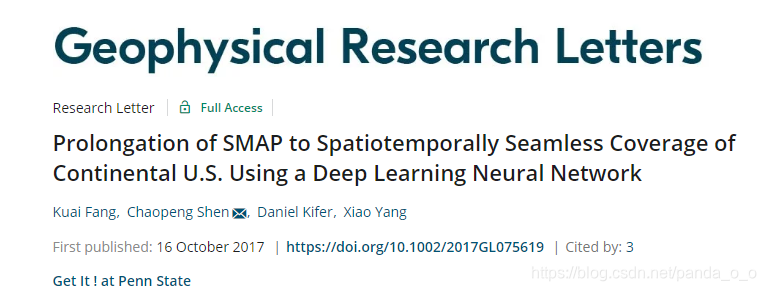- 1推荐一款YYDS的低代码开源项目:1小时创建企业专属ERP_电商erp零代码搭建
- 2Python资源汇总
- 3基于ssm+vue+Mysql的企业公寓后勤管理系统
- 4Ubuntu下PostgreSQL的安装与使用_ubuntu安装postgresql
- 5win11安装docker-desktop_win11安装docker desktop
- 6Linux 基础命令知识1_lunix 命令count
- 7java web 找回密码_java web实现 忘记密码(找回密码)功能及代码
- 8数据结构与算法——二叉树、堆、优先队列_结点的直接前驱
- 9python判断质数_python i%j==0
- 10黑屏定屏那些事 - 系统机制,分析套路和实战(系统篇)_android黑屏问题分析
1st Workshop on Leveraging Artificial Intelligence (AI) NOAA 2019 年会议报告总结记录_leveraging artificial intelligence for enhanced cy
赞
踩
Leveraging Modern Artificial Intelligence for Remote Sensing and NWP
感觉摘要就是说ML和DM的重要和优势。个人觉得总结性最好的一句话:(道出了精髓),
ML models are highly efficient and in some cases more accurate because of their flexibility to accommodate nonlinearity and/or non-Gaussianity. With that efficiency, ML can help to address the demands put on environmental products for higher accuracy, for higher resolution—spatial, temporal and vertical, for enhanced conventional medium-range forecasts, for outlooks and predictions on sub-seasonal to seasonal time scales, and for improvements in the process of issuing advisories and warnings.
解释了文章的重点AI in remote sensing and NWP
S1.2 Overview of NOAA AI Activities in Satellite Observations and NWP*
总结性,图像复原,以及辐射传输,具体看后面报告,大佬对自己人工作的介绍^_^
S2_1-1 Combining the Power of Experts and Deep Learning to Explore
NASA and NOAA Data
使用MODIS GOES 通过烟发现船的航道,厉害了
S2_1-2 Recent Application of Machine Learning Techniques to Environmental Science at PNNL
云参数,台风等。老生常谈
S2_1-4:Development of Convolutional Neural Networks for Ice and Flood Detection from Synthetic Aperture Radar (SAR)
积雪和洪水监测,但是只是提出问题,没有解决
S2_2-3:Using Deep Learning to Extract Regions of Interest from Satellite Data
Unet监测ROI(台风等气象事件),有空了解一下ROI怎么实现,和目前的发展
S2_2-4:Quantitative Precipitation Estimate Results from a Convolutional Neural Network Machine Learning Model
使用雷达数据估计雨量计降水,CNN做的结果,但是个人觉得降水的预测多看看天池比赛和predRNN等就行,而且雨量计与历史的回波也有关系,16年好像有老外用RNN做过,可以参考
S2_2-5:Deep Neural Network (DNN) Perspective On Atmospheric Motion Vectors
没做过,不知道深浅。做云导风可以参考下
DNN method can predict the winds in full coverage, whereas missing data points are present in the traditional method
S2_3-2:Developing fine-scale snow cover fraction estimates using Deep Learning
这位老哥和我在百度做的内容一样,语义分割,SRCNN哇,我用的是Unet的自己改良版。作者的精度太高了吧。神乎其神,我最后感觉xgboost做积雪使用阈值法可能好一些,语义分割不太好做边缘,和一些离群的小块积雪,不如ML。
S2_3-3:Enhancing Climate Datasets with Deep Learning
这为老哥做了我想做的,提高帧屏,参考文献想研究的看一下,我还是觉得PREDRNN等系类好一些
Jiang, Huaizu, et al. "Super slomo: High quality estimation of multiple intermediate frames for video interpolation.” CVPR 2018. (Umass, Nvidia)
S2_3-4Deep learning for estimating land surface response with uncertainty: soil moisture and other opportunities
土壤湿度,用LSTM,嗯和雨量计很像,时间的累计。老哥已经投稿JGR了
有兴趣的可以参考

S2_3-5:Deep learning estimation of tropical cyclone intensity from microwave satellite imagery
强度估计,没研究过,不知道怎么定义强度。话说应该给点其他辅助数据输入吧,或者利用一下时间序列信息。哈哈哈
S3-1 Machine Learning meets Data Assimilation
作者对数据同化和ML的cost函数做了分析。贝叶斯结构。作者提出一些思考。做同化可以一看
S3-2Improvement to Hurricane Track and Intensity Forecast by Exploiting Satellite Data and Machine Learning
国内做的人很多,17年看过一篇硕士论文,比较系统的做了用CNN结合LSTM为台风定强和定位。记得主要是路径好估计但是强度误差大,主要是辅助数据不够,例如风速,温度,压强等。此文网络结构没讲清楚,让人感觉还在研究,没有结果。
S3-3:Machine Learning Based Applications for Environmental Hazard Detection and Prediction
数据集很重要,数据集很重要,
数据集很重要,
没有好数据集,这项工作开展的瓶颈在数据集
S3-4:Development of Merged Cloud Forecasts from Satellite and Numerical Model Data
动手最快的是清华,19年发文章,云图外推,我正在做,哈哈哈
此位老哥也没清华的快。老哥你应该跟新一下技术了哈哈哈
S3-5:Data driven discretization for partial differential equations
超分,真的有应用价值。组里一个学生在做,但是以我的了解,都是用时间换空间超分。好像有是时空序列,
S4_1-1:Machine Learning for Climate Extremes: Training is Everything
目标检测,数据库很重要,有介绍,。极端气候现象的检测。是不是yolo series更好。哈哈哈
S4_1-2:Machine Learning for Moist Physics Parameterization in Weather and Climate Models
作模式的和ERA5有比较,好像看起来差不多,不知道老哥用了多少算力。估计吓人。怎么看都是DL,哈哈哈
S4_1-3machine learning techniques for analysis of high-dimensional chaotic spatiotemporal dynamical systems
没看明白,老哥PPT也是醉了,混沌系统,DL做不了呀,记得吴恩达和周志华都有提到。不知道我说的对不对。
S4_1-4 Training Neural Network Parameterizations with Near-Global Cloud-Resolving Models
做参数化的,最后的参考文献值得一看
S4_2-1:Neural Network Applications for Numerical Weather Prediction
没有干货
S4_2-2:Atmospheric Chemistry Modeling and Air Quality Forecasting using Machine Learning
已经发了一篇随机森林的,发现xgboost是好东西,哈哈哈。做预测mark一下,看看参考文献哈哈哈
S4_2-3:没干货
S4_2-4:Analog Forecast Models for Space Weather Predictions
空间天气,监测黑子,预报黑子,时序呀
S4_2-5:A deep learning model to improve WRF forecasts
使用CNN预测,我没看错吧。把WRF预测数据输入CNN预测臭氧。
S5-1Using Machine Learning to Improve Prediction and Understanding of Convective Hazards
有模型介绍

S5-3A hybrid AI hurricane forecasting system: deep learning ensemble approach and Kalman filte
休斯顿大学好多人,思路很好,不知道精度咋样和其他方法相比
S5-5Nowcasting Lightning Events with a Cloud-based Deep Learning approach
从闪电预报开始的谷歌推销,不给过,论文使用了CNN结构随机森林,GOES输入的数据,又给出链接下载闪电数据,可以试试
P1:
P1.4 Improvements in Cloud Detection Using Simple Machine Learning Models

使用模型:
LightGBM framework (Ke et al. 2017; https://github.com/Microsoft/LightGBM)
使用数据:
- One year (2016) of collocations between VIIRS (SNPP) and CALIOP are used to train and evaluate this model
- Collocations are only used under three conditions
- Time difference between the two platforms < 8 minutes
- CALIOP cloud optical depth equal to 0 or > 0.01
- •CALIOP 5 km cloud fraction equal 0 or 1.0 (no cloud edges)

P1.5 Nighttime Sea-fog Detection from Geostationary Satellite using Machine Learning

方法模型:
- Decision Tree(depth test for 2~19)
- Logistic Regression
- Multi-Layer Perceptron
- Convolutional Neural Network
- Maximum Entropy Method
- BTD&STD Method –Traditional Brightness Temperature Difference Methods with Sea Surface Temperature Difference Method to the comparison. (Shin et al., 2013)
使用数据:
- The COMS geostationary satellite for monitoring Asian Pacific region IR1(10.8 μm), IR3(6.7 μm), IR4(3.7 μm), the differences for each IR3-IR1, IR4-IR1,IR4-IR3
- Cloud Vertical Feature Mask Profile from Polar orbit satellite CALIPSO Lidar
- GHRSST Level 4 OSTIA Global Foundation Sea Surface Temperature
- 2011~2014 May-July, the most frequently sea-fog generated season
- The true fog pixels defined from CALIPSO Vertical Feature Map data(Wu et al., 201)
P1.12 Interpretable AI for Deep-Learning-Based Meteorological Applications 试图用物理解释模型,但是感觉一团糟
P1.14AI for water infrastructure mapping in Africa作者试图想应用AI解决水利建设的识别和水网的识别。不涉及AI
P1.15 Dimensionality Reduction for Fast and Accurate Radiative Transfer
PCA降维
P1.21Reconstruction of Missing Data in GOCI AOD using a Deep Learning Algorithm
U-net来做缺失填充,克里金插值,也是有趣,缺经费?图是好看,但是定量化不知道好不好,填充我觉得试试强化学习,假图制作溜得飞起,应该会好。另外使用地基数据稍微订一下也行吧。个人感觉使用时空序列网络估计回来。
P1.24 GSICS Action Tracker: A Supervised Machine Learning Content
Extraction Tool on Google Cloud 多人协作的管理方式,好思路但是我们用不了,是不是可以让百度阿里看看^_^
P2.3 Creating Synthetic Weather Radar Images Using Convolutional Neural Networks 多源数据融合的,但是目前来看方法落后(而且很难收敛吧,不知道作者怎么弄出的结果)
P2.13 Learning to automatically detect avalanche deposition
from SAR satellite imagery

是不是可以用来识别地质灾害等,哈哈哈
P7 Translating Weather and Satellite Data into Actionable Climate Information: A Framework and Overview
作物产量估计很好的一片流程总结式论文。
报告下载链接https://www.star.nesdis.noaa.gov/star/meeting_2019AIWorkshop.php


